Baggott J. The Meaning of Quantum Theory: A Guide for Students of Chemistry and Physics
Подождите немного. Документ загружается.

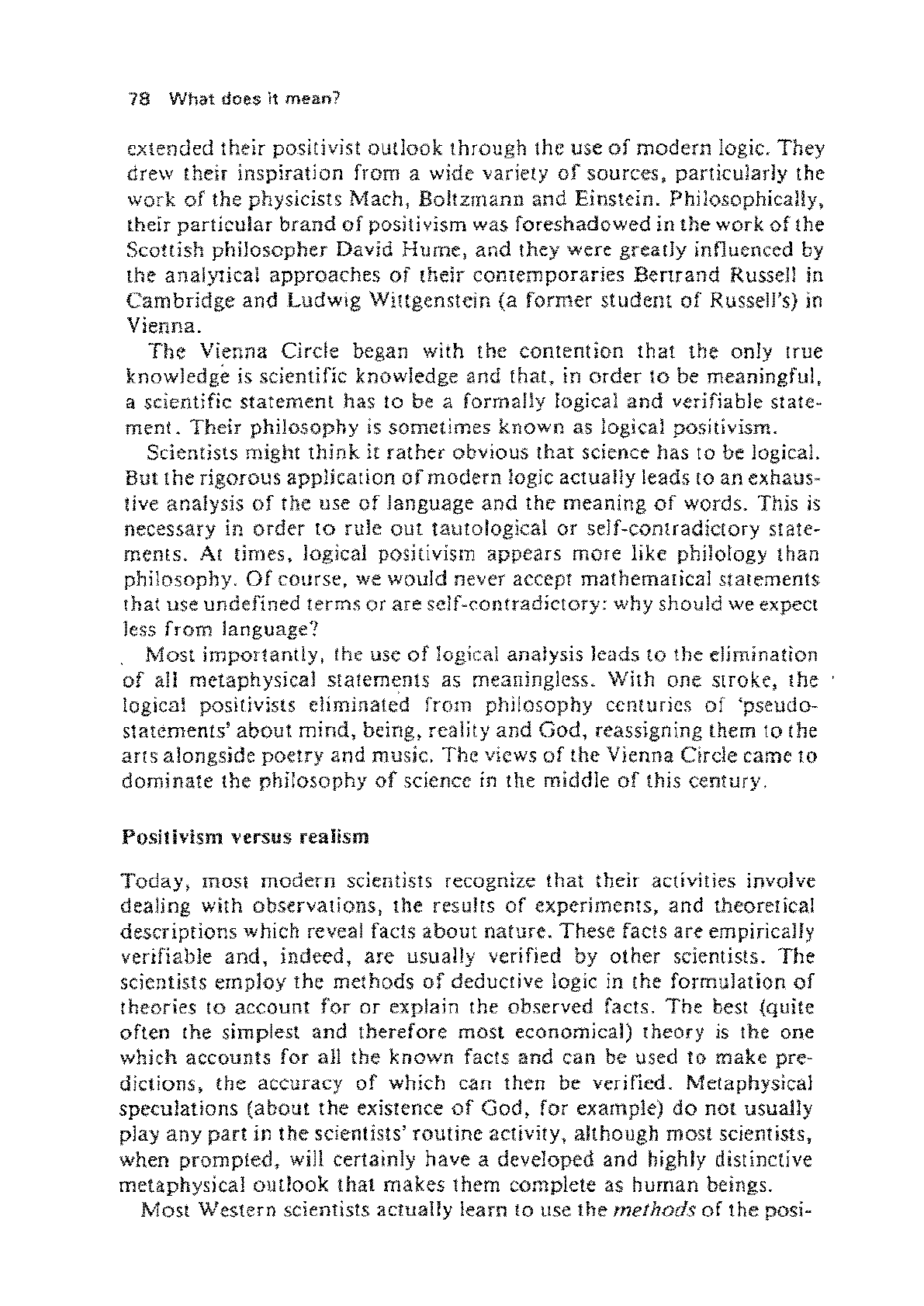
78
What
does
it
mean?
extended
their
positivist
outlook
through
the use
of
modern
logic. They
drew their
inspiration
from a wide variety
of
sources,
particularly the
work
of
the physicists
Mach,
Boltzmann
and
Einstein. Philosophically,
their
particular
brand
of
positivism was
foreshadowed
in
the
work
of
the
Scottish
philosopher
David
Hume,
and
they were
greatly
influenced by
the analylicai
approaches
of
their
contemporaries
Bertrand
Russell in
Cambridge
and
Ludwig
Wittgenstein (a
former
student
of
Russell's) in
Vienna.
The
Vienna Circle began with the
contention
that
the
only true
knowledge is scientific knowledge
and
that.
in
order
to
be meaningful,
a scientific
statement
has to be a formally logical
and
verifiable slate-
ment.
Their
philosophy
is
sometimes
known
as logical positivism.
Scientists might
think
it
rather
obvious
that
science has to be logical.
But
the
rigorous
application
of
modern
logic actually leads to an exhaus-
tive
analysis
of
the use
of
language
and
the
meaning
of
words. This
is
necessary in
order
to
rule
out
tautological
or
self-contradictory state-
ments.
At times, logical positivism
appears
more like philology
than
philosophy.
Of
course,
we would never accept
mathematical
statements
that
use undefined terms
or
are
self-contradictory: why should we expect
less
from
language"?
Most
importantly,
the use
of
logical analysis leads
to
the
elimination
of
all metaphysical
statements
as meaningless. With
one
stroke,
the
logical positivists eliminated from
philosophy
centuries
of
'pseudo-
slatements'
about
mind,
being, reality
and
God,
reassigning them
to
the
arts
alongside
poetry
and
music.
The
views
of
the Vienna Circle came
to
dominate
the
philosophy
of
science
in
the middle
of
this
cemury.
Positivism versus realism
Today,
most
modern
scientists recognize
that
their actlvltles involve
dealing with
observations,
the results
of
experiments,
and
theoretical
descriptions which reveal facts
about
nature.
These facts
are
empirically
verifiable
and.
indeed,
are
usually verified by
other
scientists.
The
scielltists
employ
the
methods
of
deductive logic in the
formulation
of
theories
to
account
for
or
explain the observed facts.
The
best (quite
often
the simplest
and
therefore
most
economical) theory
is
the one
which accounts for all
the
known
facts
and
can
be used
to
make
pre-
dictions,
the
accuracy
of
which can then be verifIed. Metaphysical
speculations
(about
the
existence
of
God,
for example)
do
not
usually
play
any
part
in
the
scientists'
routine
activity, although
most
scientists,
when
prompted.
will certainly
have
a developed
and
highly distinctive
metaphysical
outlook
Iha!
makes
them complete as
human
beings.
Most
Western scientists actually learn
to
use
the
methods
of
the
posi-

Positivism
79
tlVlst
during
their
formal
education.
Although
there
are
undoubtedly
some
'grey' areas,
young
scientists
are
instructed by their teachers
as
to
what
Qualifies as science, what
'doing
science'
means
and
how
it
should
ideally be
conducted.
They
learn
to
adopt
a
pragmatic,
sceptical
approach
to
science in which
philosophy
-
and
particularly
metaphysics-appears
to play
no
part.
However,
for
many
scientists the
stuff
of
their
theories-atoms.
electrons,
photons,
etc.
-are
quite
'real'.
Many
assume
these objects to
have
an
existence
independent
of
the
instruments
used
to
produce
the
effects
their
theories are
supposed
to
explain. It
would,
perhaps, be very
difficult
for
high-energy physicists
to
justify
the financial investments
needed
to
build
larger
and
larger
panicle
accelerators
if
they were not
convinced
of
the reality
of
the
objects
on
which
they
wish to make
measurements.
Most
scientists
attempt
to
uncover
the
independent
physical reality lying
underneath
the
phenomena:
to
explain
why the
world
is
the
way
it is, which goes beyond
merely
registering Ihe fact
that
instrument
A will give effect B
under
conditions
C.
This
position.
in
which it is held
that
there exists a reality which
is
independent-:-ofihe
·(lbserv~f-affirfhe
insfnimeu!.S..tJ.SedJ1l
iJiii.l<EciEsei::.i:uinns,
~;TIr(der
U;:.
aT-reaITSm~----
----t;,: .. rigorotls positiVist
would
question
the usefulness
of
searching too
hard for
such
an
independent
reality.
although
it
would
be
a
mistake
to
suppose
that
an
uncompromising
positivist stance
wouldnecessarily
lead
us
to
deny a reality
fhat'
we·cannoi'-dTredTrperCeiVe.-Sclilick
himself
declared this kind
of
~ea~(ming
'simplyabsil'fd';
iii,rrefusedlOaccepf
that
it is implied in the
philosophy
of
10gicaJpositivism (altlioug1fWe
should
note
that
not
every
logicaI1'9s.i.r.i.Ylst
wiHij.ill1e(;~ssarilxagree
with
him).
'.
. -
..'
--'.'
.
-However,
there
i.s
a
Qist,il1cticm
.IQ
.!1~m.ll!!"-,~_.Ie"HsLl]1jlthJ
.Q!;...£.Q!1:
vinced
that
there
iLanindependen!
reality
'out
there'
which
is
probed
through
observation
and
experiment.
AQ9sitivist accei2!silJaHhere
ire
elements
of
an
emp1ficdl
realitVwhich
are
probed
in
this
way;ljui
1'oinl5
ouiiliaTtfie-realistv,ewinvo!ves-<ilogiCruTontradlctio;;-:sIilee
we~'
noway
olobserving
an'O!JseiVi'f:inaepeooentreaITi.Yarld
hence
wecan-
.'
n§tverif);:tllaisucb
'ire:lIi(iexistCWe-liavenomea~s:Of;;-cqiiirrii~
\
knowledge
6f!1!!'
PE~s'.cal~().r!~L<:?,c~tthrougli
?6~ervat~nd
experi:'
1
ment,
and
so the reality we
pro.b,U~
.•.
.9(
Drugit)',
dependent
on
the
observer
for'
its exisferice':
The
positivist
arguest}1a!~since
we
cannoT
v~fy
Ihe,.:xis!~(:e
Qf
.an
o!ls~rvel:hi~epe!.'g~riLi~lity
...
~ucl1~r~f~~
rnetapliYslcal
and
therefore
qUIte Without
meaml1J!.:..
The
logical
con·
traaTCiion
fmpliedTiHhe, realist's vlew'sside:ste-pped
oniYliY
anapp;;al
w!heemotronsorto
fa'tn:·
--
.----------.-'
-.
'-~-.
-
Am~der~·scieniisirrirgFit
typically
adopt
th~
methods
of
the
positivist
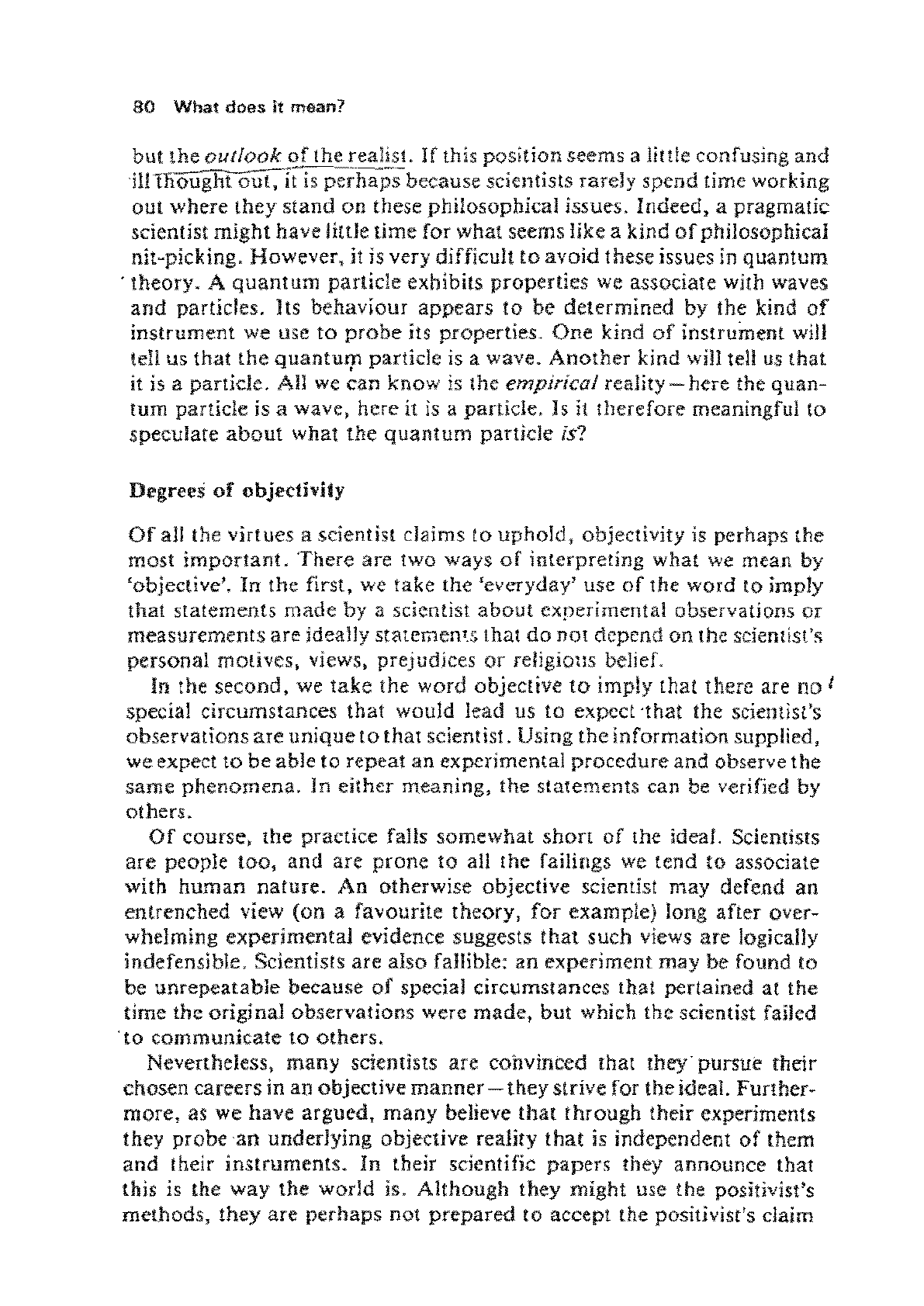
SO
What
does
it
mean?
bul
the
au/look
of
Ihe realist.
If
this position seems a lillie confusing and
il!
lllOilgiifOii!,.t
is
perhaps-because scientists rarely spend time working
out
where
they
stand
on
these philosophical issues. Indeed, a pragmatic
scientist
might
have little time for what seems like a kind
of
philosophical
nit-picking. However, it is very
difficullto
avoid
these issues in
quantum
. theory. A
quantum
particle exhibits properties
we
associate with waves
and
particles. Its behaviour appears
to
be
determined by
the
kind
of
instrument
we use
to
probe
its properties.
One
kind
of
instrument
will
lell
us
that
the
quantum
particle is a wave.
Another
kind will tell liS
that
,
it is a particle. All
we
can know
is
the
empirical reality - here the
quan-
tum
particle
is
a wave, here it
is
a particle. Is
it
therefore meaningful to
speculate
about
what
the
quantum
particle is?
Degrees
of
objectivily
Of
all the virtues a scientist claims
to
uphold,
objectivity is perhaps the
most
important.
There
are
two
ways
of
interpreting what
we
mean by
'objective'.
In
the
first,
we
take the 'everyday' use
of
the
word to imply
that
statements
made
by a scientist
about
experimental observations
or
measurements
are
ideally statemen'.! that
do
no! depend
on
the sciemist's
personal mOlives, views, prejudices
or
religiollS belief.
In the second,
we
take
the
word objective
to
imply
that
there are
no
I
special circumstances
that
would
lead us to expect ·thal
the
scielltisi's
observations
are
unique
to
that scientist. Using
the
information
supplied,
we expect
to
be
able to repeat
an
experlmental
procedure
and
observe
the
same
phenomena.
In either meaning, the statements can
be
verified by
others.
Of
course, the practice falls
somewhat
shon
of
the Ideal. Scientists
arc
people
too,
and
are
prone
to
all the failings
we
tend
to
associate
with
human
nature.
An
otherwise objective scientist may defend
an
entrenched view (on a favourite theory,
for
example) long afler over-
whelming
experimental evidence suggests
that
such views
are
logically
indefensible. Scientists are also fallible;
an
experiment
may
be
found to
be
unrepealable
because
of
special circumstances that pertained at
the
time Ihe original observations were made, but which the scientist failed
.
to
communicate
to
others.
Nevertheless,
many
scientists
are
convinced that they· pursue their
chosen
careers in an objective
manner
-
they
strive for the ideal. Further-
more, as we have argued.
many
believe
that
through their experiments
they probe
an
underlying objective reality
that
is
independent
of
them
and
their
instruments.
In
their scientific
papers
they announce that
this is the
way
the
world is. Although they might use the positivist's
methods,
they
are
perhaps
!lot
prepared
to accept the positivist's claim
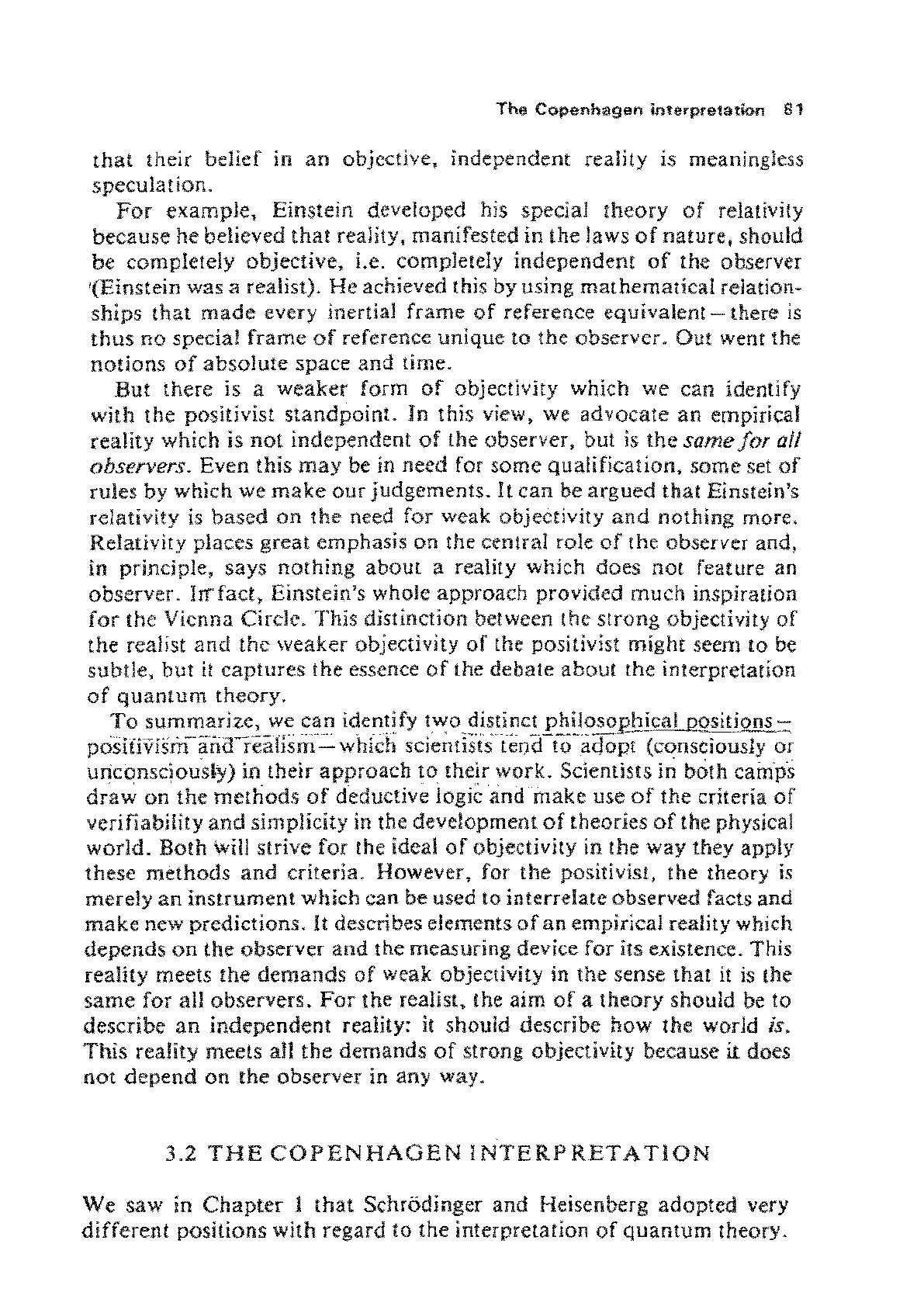
The
Copenhagen
interpretation
81
that
their belief
In
an
objective. independent reality is meaningless
speculation.
For
example. Einstein developed his special theory
of
relativity
because
he believed
that
reality, manifested in the laws
of
nature, should
be completely objective, i.e. completely
independent
of
the observer
'(Einstein was
a realist). He achieved this by using mathematical relation-
ships
that
made
every inertial frame
of
reference equivalent - there
is
thus
no
special
frame
of
reference unique to the observer. Out went the
notions
of
absolute
space
and
time.
But there is a weaker form
of
objectivity which we can identify
with the positivist
standpoint. In this view, we advocate
an
empirical
reality which is
not
independent
of
the observer, but is
the
same
for
all
observers. Even this
may
be
in
need for some qualification, some set
of
rules by which we
make
our
judgements. It can be argued thaI Einstein's
relativity
is
based
on
the
need for weak objectivity
and
nothing more.
Relativity places great emphasis on the
central role
of
the observer and,
in principle, says nothing about a reality which does
not
feature an
observer.
lrrfact,
Einstein's whole approach provided much inspiration
for
the Vienna Circle. This distinction between the
strong
objectivity
of
the realist
and
the weaker objectivity
of
the positivist might seem to
be
SUbtle, but
it
captures the essence
of
the debate about the interpretation
of
quantum
theory.
To
summarize,
we
can identify two distinct
philoso£hjcJl!..J1QsitI9~:::
posiiiviSmanirrealism':::' which scientIsts l.enCCio-adopr (consciously or
unconsciously) in their approach
to
their work. Scientists
in
both camps
draw
on
the
methods
of
deductive logic and make use
of
the criteria
of
verifiability
and
simplicity
in
the development
of
theories
of
the physical
world. Both
will strive for the ideal
of
objectivity in the way they apply
these methods
and
criteria. However, for the positivist, the theory
is
merely
an
instrument which can be used to interrelate observed facts and
make
new predictions.
It
describes elements
of
an
empirical reality which
depends
on
the observer
and
the measuring device for ils existence. This
reality meets
the demands
of
weak objectivity
in
the sense that
it
is
the
same
for all observers.
For
the realist, the aim
of
a theory should
be
to
describe
an
independent reality:
it
should describe how the world is.
This
reality meets all the demands
of
strong objectivity because
it
does
not
depend
on the observer in any way.
3.2
THE
COPENHAGEN
INTERPRETATION
We saw in
Chapter
1
that
Schrodinger and Heisenberg adopted very
different positions with regard
to
the interpretation
of
quantum
theory.
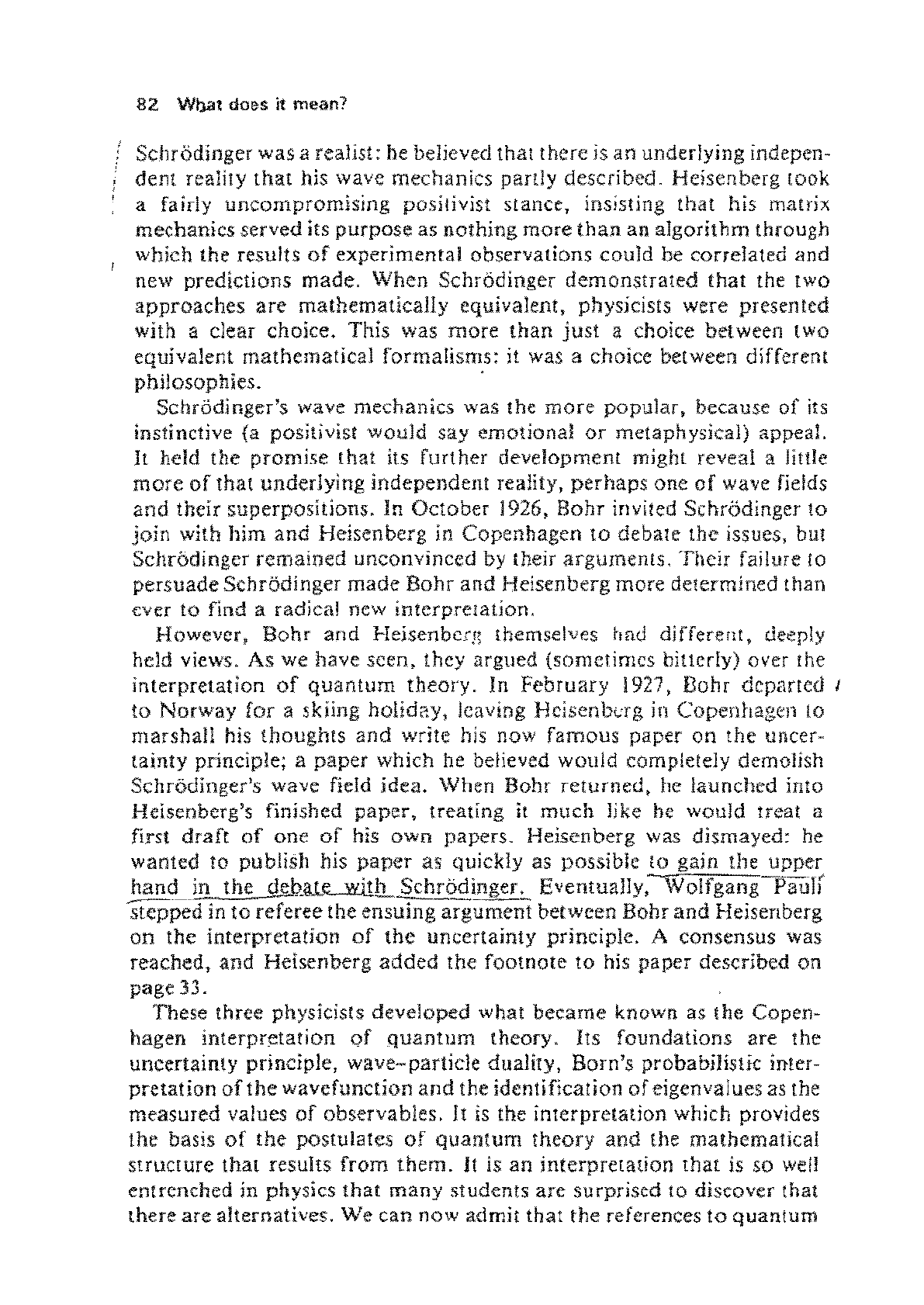
82
Wbat
does
it
mean?
Schrodinger
was
a realist: he believed
that
there
is
an
underlying
indepen-
dent
reality
that
his wave
mechanics
partly
described"
Heisenberg
took
a fairly
uncompromising
positivist stance, insisting
that
his matrix
mechanics
served
its
purpose
as
nothing
more
than
an
algorithm
through
which
the
results
of
experimental
observations
could
be
correlated
and
new
predictions
made.
When
Schrodinger
demonstrated
that
the
twO
approaches
are
mathematically
equivalent,
physicists were presented
with
a
clear
choice.
This
was
more
than
just
a choice between
two
equivalent
mathematical
formalisms:
it was a
choice
between
different
philosophies.
.
Schrodinger's
wave
mechanics
was the
more
popular,
because
of
ils
instinctive
(a
positivist
would
say
emotional
or
metaphysical)
appeal.
It
held
the
promise
that
its
further
development
might reveal a little
more
of
that
underlying
independent
reality,
perhaps
one
of
wave fields
and
their
superpositions.
In
October
1926,
Bohr
invited
Schrodinger
to
join
with
him
and
Heisenberg
in
Copenhagen
to
debate
the
issues, but
Schrodinger
remained
unconvinced
by their
arguments.
Their
failure to
persuade
Sehrodinger
made
Bohr
and
Heisenberg
more
determined
than
ever
to
find a radical new
interpretation.
However,
Bohr
and
Heisenberg
themselves had
different,
deeply
held views.
As
we have
seen,
they
argued
(sometimes
bitterly)
over the
interpretation
of
quantum
theory.
In
February
1927,
Bohr
departed
I
to
Norway
for
a skiing
holiday,
leaving Hcisenbc:rg in
Copenhagen
[0
marshall
his
thoughts
and
write
his now
famous
paper
on
the
uncer-
tainty
principle; a
paper
which
he believed
would
completely demolish
Schrodinger's
wave
field
idea.
When
Bohr
returned,
he
launched
into
Heisenberg's finished
paper,
treating
it
much
like he
would
treat a
first
draft
of
one
of
his
own
papers.
Heisenberg
was
dismayed:
he
wanted
to
publish
his
paper
as
quickly as
possible
!O gain
the
upper
hand
in
the
dw.~!:L
Scnrodinger.
Eventually,Wolfgang
Paull
-----
--
.
stepped
in
to
referee
the
ensuing
argument
between
Bohr
and
Heisenberg
on
the
interpretation
of
the
uncertainty
principle.
A
consensus
was
reached,
and
Heisenberg
added
the
footnote
to
his
paper
described
on
page
33.
These
three
physicists
developed
what
became
known
as
the
Copen-
hagen
interpretation
of
quantum
theory.
Its
foundations
are
the
uncertainty
principle,
wave~particle
duality,
Born's
probabilistic
inter-
pretation
of
the
wavcfunction
and
the
identification
of
eigenvalues as the
measured
values
of
observables.
It
is
the
interpretation
which provides
the basis
of
the
postulates
of
quantum
theory
and
the
mathematical
structure
that
results
from
them.
It
is
an
interpretation
that
is
so
well
entrenched
in
physics
that
many
students
are
surprised
to
discover
that
there
are
alternatives.
We
can
now
admit
that
the
references
to
quantum
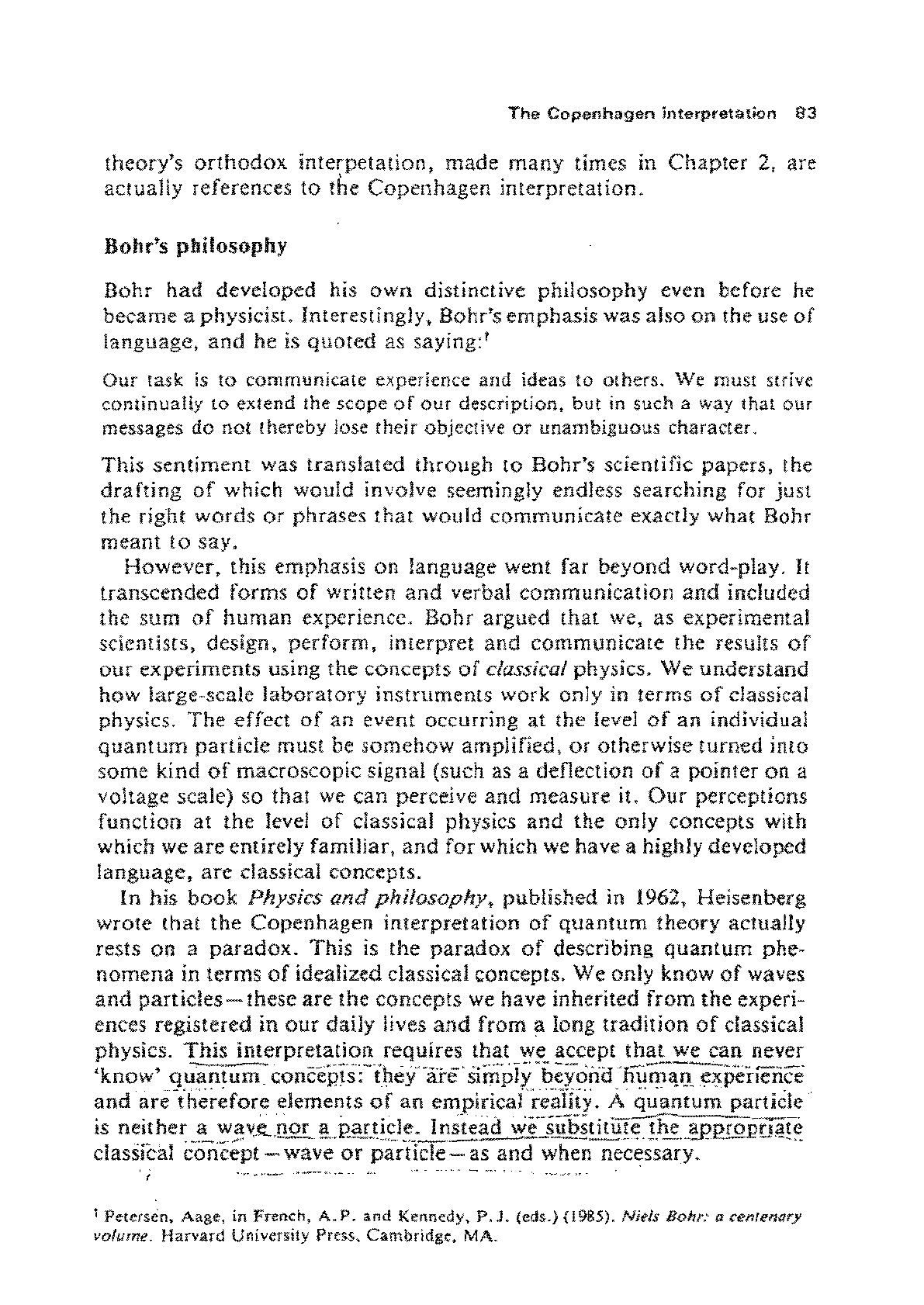
The
Copenhagen
interpretation
83
theory's
orthodox
interpetation, made
many
times in
Chapter
2, are
actually references
to
the Copenhagen interpretation.
Bohr's
philosophy
Bohr had developed his own distinctive philosophy even before
he
became a physicist. Interestingly. Bohr's emphasis was also
on
the use
of
language,
and
he is
quoted
as saying:'
OUf
task is
to
communicate experience and ideas to others. We must strive
continually
to
extend
the
scope
of
our description, but
in
such a way
that
our
messages do not thereby
Jose
their objective or unambiguous character.
This
sentiment
was translated through to Bohr's scientific papers, the
drafting
of
which would involve seemingly endless searching for just
the right words
or
phrases
that
would communicate exactly what Bohr
meant
to
say.
However, this emphasis
on
language went far beyond word-play.
It
transcended forms
of
written
and
verbal communication
and
included
the sum
of
human
experience. Bohr argued that we, as experimental
sciemists,
design.
perform.
interpret
and
communicate the results
of
our
experiments using the concepts
of
classical physics, We understand
how
large-scale
laboratory
instruments work only in terms
of
classical
physics.
The
effect
of
an
event occurring
at
the level
of
an
individual
quantum
particle must be somehow amplified.
or
otherwise turned imo
some kind
of
macroscopic signal (such as a deflection
of
a pointer
on
a
voltage scale) so that we
can
perceive
and
measure it.
Our
perceptions
function
at
the level
of
classical physics
and
the
only concepts with
which we
are
entirely familiar,
and
for which
we
have a highly developed
language,
are
classical concepts.
In his book Physics
and
philosophy,
published in 1962, Heisenberg
wrote
that
the
Copenhagen interpretation
of
quantum
theory actually
rests
on
a
paradox.
This
is
the paradox
of
describing
quantum
phe-
nomena in terms
of
idealized classical concepts. We only know
of
waves
and
particles - these
are
the concepts
we
have inherited from
the
experi-
ences registered in
our
daily lives
and
from a long tradition
of
classical
physics.
This
interpretation requires that we accept
that
we
can
never
'know'
qUlmt~
concep!s:-ihey'are
simply
-beyoridnuma.1J:-experlence
and
are
-iherefore elements
of
an
empiricai
rea.liiji,
A (juantum partiCle·
, ' "
'.
,.
'-',
._-------
--~~----.
IS neither
_~"'3!~~.!)~
!L2i!Ltl"I~_:JE~~JlJ!!1.§t
itute
the'!PQrol?!Ji!!~
classical concept
~
wave
or
particle
~
as
and
when necessary.
, '
,.
-
..
-- ._--. -
i Petersen. Aage.
in
French,
A.P.
and Kennedy,
P,].
(cds.) (l985). Niels Bohr.' a cenfenary
volume. Harvard University Press, Cambridge. MA.
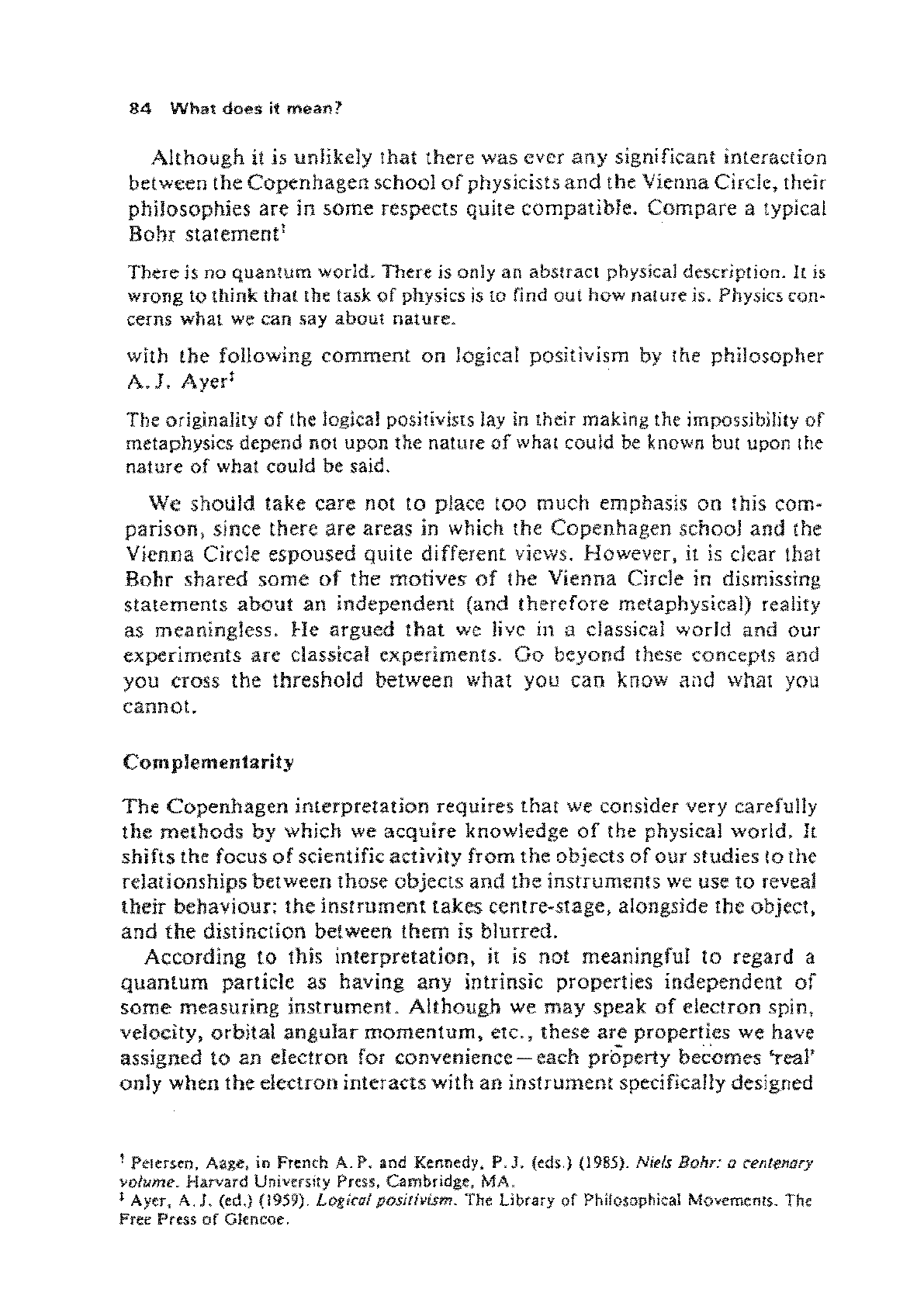
84
What
does
it
mean
'!
Although
it
is unlikely
that
there
was ever
any
significant interaction
between
the
Copenhagen
school
of
physicists
and
the
Vienna Circie, their
philosophies
are in
some
respects
quite
compatible.
Compare
a typical
Bohr
statement'
There
is
no
quantum
world. There is only an
abstract
physical description.
It
is
wrong to think that
the
task
of
physics
is
10
find out how nature is. Physics con·
cerns
what
we can say
about
nature.
with
the
following
comment
on
logical positivism by the
philosopher
A. J.
Ayer'
The originality
of
the logical positivists lay in their making the impossibility
of
metaphysics depend not upon
the
nature
of
what could be known but upon the
nature
of
what could be said.
We
should
take
care
not
to
place
too
much
emphasis
on
this
com·
parison,
since
there
arc
areas
in which
the
Copenhagen
school
and
the
Vicnna
Circle
espoused
quite
different
views.
However,
it is clear that
Bohr
shared
some
of
the
motives
of
the
Vienna
Circle in dismissing
statements
abollt
an
independent
(and
therefore
metaphysical) reality
as
meaningless.
He
argued
that
we live in a classical
world
and
our
experiments
are
classical experiments.
Go
beyond
these
concepts
and
you
cross
the
threshold
between what you
can
know aild what you
cannot.
Com
plemclllarity
The
Copenhagen
interpretation
requires
that
we consider very carefully
the
methods
by
which we
acquire
knowledge
of
the
physical
world.
It
shifts
the focus
of
scientific
activity
from
the
objects
of
our
studies
to
the
relationships
between
those
objects
and
the
instruments
we
use
to
reveal
their
behaviour:
the
instrument
takes
centre-stage, alongside
the
object,
and
the
distinction between
them
is
blurred.
According
to
this
interpretation,
it is
not
meaningful
to
regard a
quantum
particle
as having
any
intrinsic properties
independent
of
some
measuring
instrument.
Although
we
may
speak
of
electron spin,
velocity,
orbital
angular
momentum,
etc.,
these
are
properties we have
assigned
to
an
electron for convenience - each
prbperty
becomes
'real'
only
when
the
electron
interacts
with
an
instrument
specifically designed
t Pelers.co, Aage. in French
A.
P. and Kennedy. P.
J.
(eds.) (1985). Nie{s
Bohr:
a I:enlt!nory
volume. Harvard University Press, Cambridge, MA
t
Ayer,
A.l.
(cd,} (1959). Logit:u/
positivism.
The Library
of
Philosophical Movemenrs. The
Free Press
of
Glencoe.
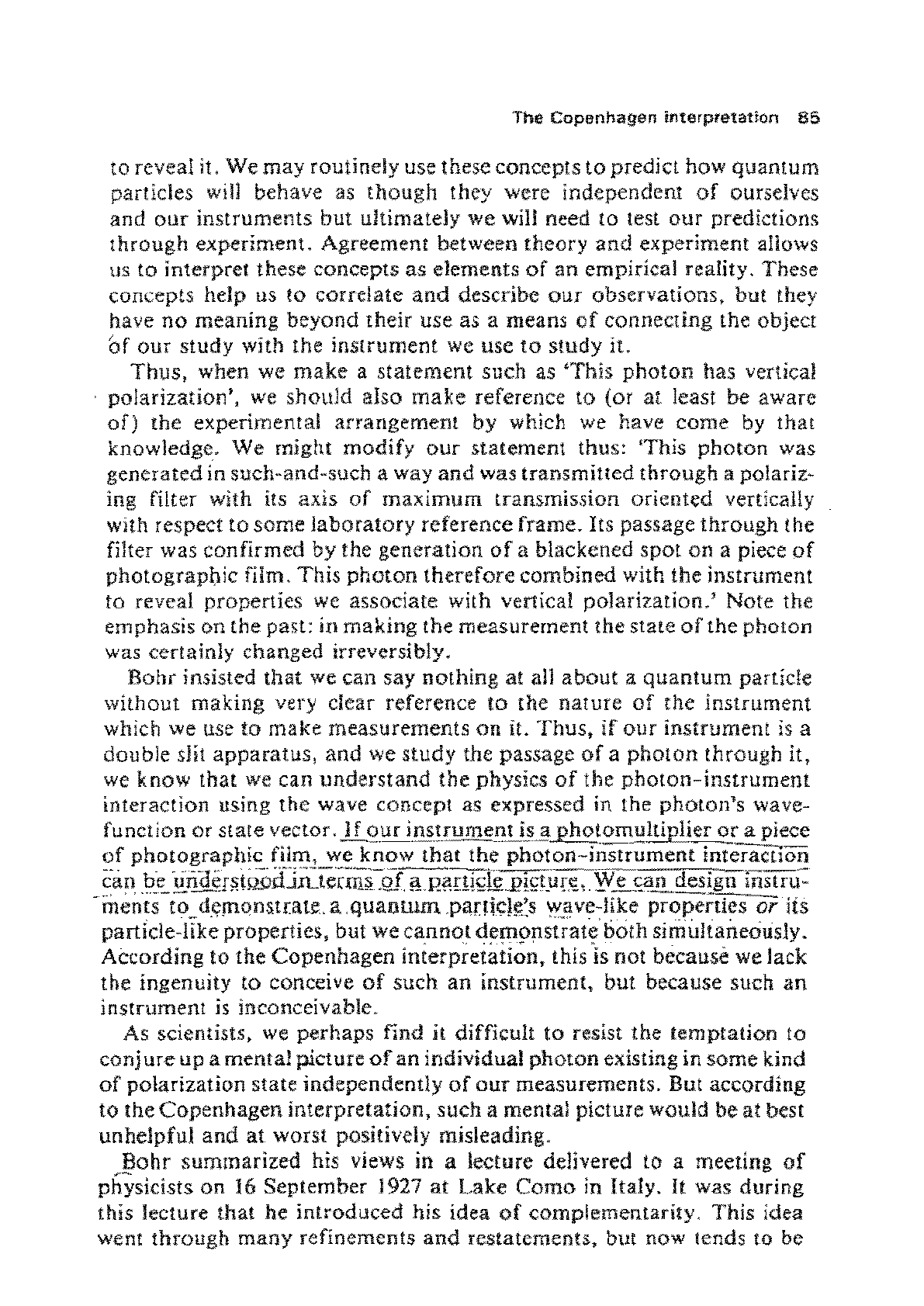
The
Copenhagen interpretaHon
85
to reveal it.
We
may routinely use these concepts to predict how quantum
particles
will
behave
as
though they were independent
of
ourselves
and
ollr instruments but ultimately we will need
to
test
our
predictions
through experiment. Agreement between theory
and
experiment allows
us
to interpret these concepts as elements
of
an empirical reality. These
concepts help us to correlate
and
describe
our
observations, but they
have
no
meaning beyond their use as a means
of
connecting the object
Sf
our study with the instrument
we
use
to
study it.
Thus.
when we
make
a statement such as 'This
photon
has vertical
polarization',
we
should also make reference to (or
at
least be aware
of)
the experimental arrangement by which
we
have come
by
that
knowledge. We might modify
our
statement thus: 'This
photon
was
generated
in
such-and-such a way
and
was transmi!!ed through a polariz-
ing filter with its axis
of
maximum transmission oriented vertically
with respect to some laboratory reference frame. Its passage through the
filter was confirmed by the generation
of
a blackened spot on a piece
of
photograpl)ic film. This
photon
therefore combined with the instrument
to reveal properties
we
associate with vertical polarization.' Note the
emphasis on the past: in making the measurement
the state
orthe
photon
was certainly changed
irreversibly,
Bohr insisted that
we
can say nothing at all
about
a
quantum
particle
without making very clear reference 10 the nature
of
the instrument
which
we use
to
make measurements
on
it.
Thus,
if
our
instrument
is
a
double slit apparatus. and we study the passage
of
a
photon
through it,
we
know that
we
can understand the physics
of
the
photon-instrument
interaction using the wave concept as expressed in the photon's wave-
function or state vector. Jl.(jur instrume
l1
tJ§.'!
phot0ITll!ltipli~
a piece
of
photographic film,
we
know thaI Ihe photon-instrument interaCtion
c·anbe_una~r~tW)ifJnler:m~-:gf.
i!p.l!~je
J?!£t.u~W
l'-.flllL
des~gn
mstrU::
.
menu
to d'JUonstra!e. a quaotump.mie!",:s wave-like properties
or
its
partide.lik~
properties, but we
cannot
demonsi~ate
both simultaneouslY,
According to the Copenhagen
interp~eia!i';n,
this 'is not because we lack
the ingenuity to conceive
of
such an instrument, but because such
an
instrument
is
inconceivable.
As scientisls,
we
perhaps find it difficult to resist the temptation to
conjure up a mental picture
of
an individual photon existing in some kind
of
polarization state independently
of
our
measurements. But according
to the Copenhagen interpretation, such a mental picture would be at best
unhelpful
and
at worst positively misleading.
Bohr summarized his views in
a lecture delivered to a meeting
of
physicists on
16
September 1927 at Lake
Como
in
Italy, It was during
this lecture that he introduced his idea
of
complementarity. This idea
went through many refinements
and
restatements, but now tends to be
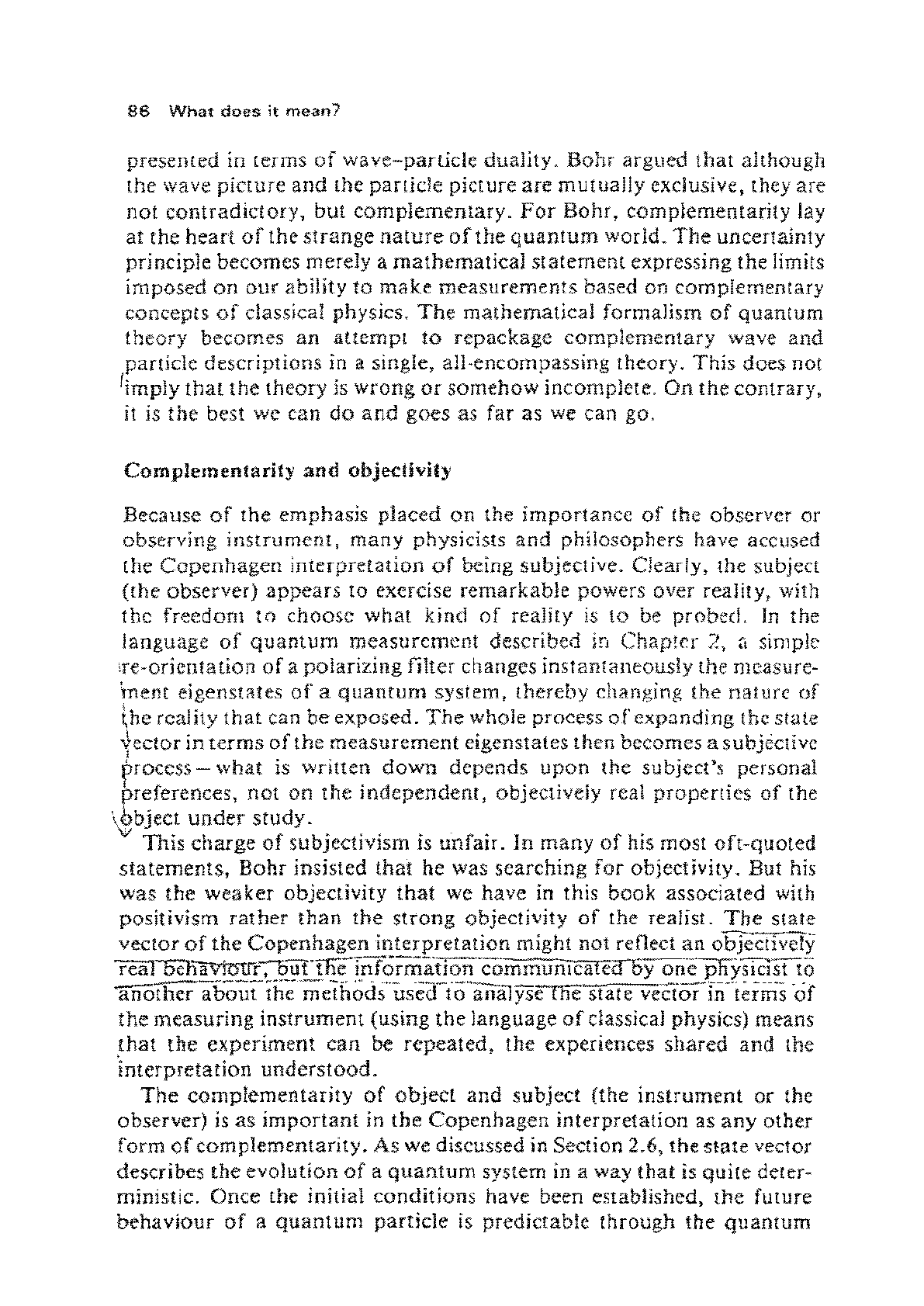
86
What
does it mean?
presented in terms
of
wave-particle
duality.
Bohr
argued
that
although
the wave
picture and the particle picture
are
mutually
exclusive, they are
not
contradictory,
but
complementary.
For
Bohr, complementarity lay
at
the
heart
of
the
strange
nature
of
the
quantum
world,
The
uncertainty
principle becomes merely a
mathematical
statement
expressing
the
limits
imposed on
our
ability
to
make
measurements
based on complementary
concepts
of
classical physics,
The
mathematical formalism
of
quantum
theory becomes
an
attempt
to
repackage complementary wave and
particle descriptions in a single, all,encompassing theory,
This
does not
limply
that
the
theory is
wrong
or
somehow incomplete.
On
the
contrary,
it
is
the
best we can
do
and
goes as rar as
we
can go,
Complementarity
and
objeclivily
Because
of
the
emphasis placed
on
the
importance
of
the observer or
observing
instrumen!, many physicists
and
philosophers have accused
the
Copenhagen
interpretation
of
being subjective, Clearly, the subject
(the
observer)
appears
to exercise remarkable powers over reality, with
tbe
freedom
to
choose
what
kind
of
reality
is
to be
probed.
In
the
language
of
quantum
measurement described
if,
Chapter
2,
r.
simple
,rc,orictJlation
of
a polarizing filter changes instal1laneous!y the measure-
inem
eigenstates
of
a
quantum
system, thereby changing the nature
of
(he reality
that
can
be
exposed,
The
whole process
of
expanding the state
--lector
in
terms
of
the measurement eigenstate, then becomes a subjective
process - what
is
written
down
depends
upon
the subject's personal
preferences,
not
on
the
independent,
objectively real properties
of
the
\bbject
under
study,
v This
charge
of
subjectivism is unfair,
In
many
of
his most
oft-quoted
statements,
Bohr insisted that he was searching
for
objectivity, But his
was the
weaker
objectivity
that
we have in this book associated with
positivism
rather
than
the
snong
objectivity
of
the realist.
The
stale
vector
of
the
Copenhagen
interpretation
might not reflect
an
ob)eruvely
realoCliavimrr;ollfme'lnformaifi5i1·cci:mffiurilcaleaby
onepnysidst
to
___
~
___
••
~.
__
"_"
__
" ,
...
_h
_____
._~____
_
_______
•
______
_
"1ii1other
about
the
methods
used
to
anaJysenie
state vector in terms ·of
the
measuring instrument (using
tbe
language
of
classical physics) means
,that the experiment can be
repeated,
the experiences shared and the
interpretation
understood,
The
complementarity
of
object
and
subject (the instrument
or
the
observer)
is
as
important
in
the
Copenhagen interpretation as
any
other
form
of
complementarity.
As we discussed in Section 2,6, the
state
vector
describes the evolution
of
a
quantum
system in a way
that
is
quite deter-
ministic, Once the initial
conditions
have been established,
the
future
behaviour
of
a
quantum
particle
is
predictable through Ihe
quantum
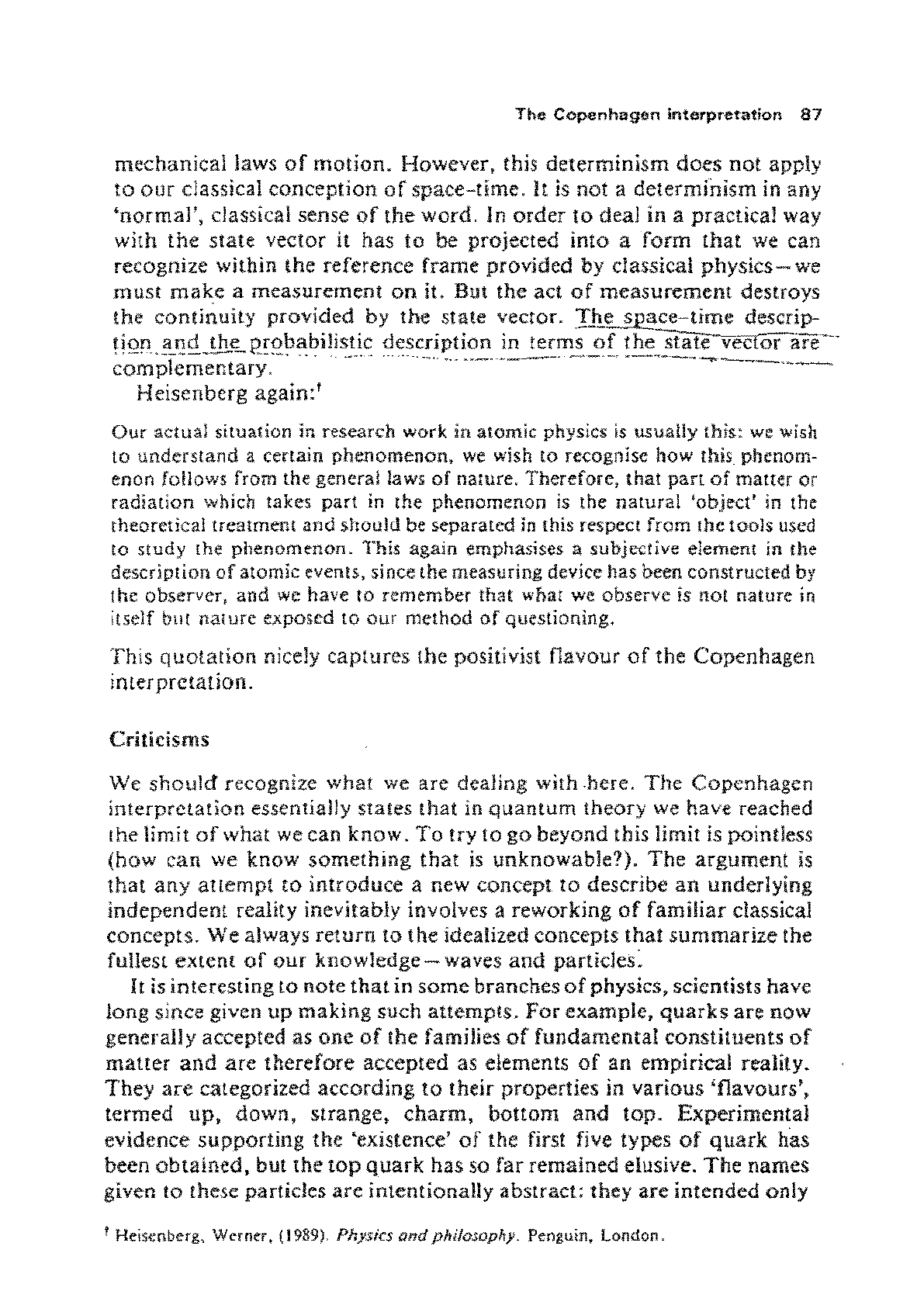
The
Copenhagen
Interpretation
87
mechanical
laws
of
motion.
However, this
determinism
does
not
apply
to
our
classical
conception
of
space-time,
It
is
not
a
determinism
in
allY
'normal',
classical sense
of
the
word,
In
order
to
deal in a
practical
way
with
the
state
vector
it
has
to
be
projected
into
a
form
that
we can
recognize within
the
reference
frame
provided
by
classical
physics-
we
must
make
a
measurement
on
it. But
the
act
of
measurement
destroys
the
continuity
provided
by
the
state
vector.
rJl~ce-time
descr;p-
tiQn ,,,-l)d, thJ;_Rr£babilistic
description
in terms
of
the
Stat:evecwrare'"
complementary,
' " ",.'"
"'",
,,,
"",
-,,~"
-'--
'-"--~---,---
Heisenberg
again:'
Our
actual
situation in research work in
atomic
physics
is
usuaHy this: we wish
to
understand
a certain
phenomenon.
we
wish
to
recognise
how
this
phenom-
enon
follows from the
general
law,
of
"amre,
Therefore, that
pan
of
matter
or
radiation
which takes
part
in
the
phenomenon
is
the
natural
'object'
in
the
theoretical
treatment
and
shouJd be separated
in
this respect
from
lhe
tools
used
to
study
[he
phenomenon.
This
again
emphasises a SUbjective element in {he
description
of
atomic
events. since the measuring device
has
been
constructed
by
the
observer,
and
we have
to
remember
that
what we
observe
is
not
nature
in
Itself but
nature
exposed
to
our
method
of
questioning.
This
quotation
nicely
captures
the
positivist
flavour
of
the
Copenhagen
inter
prctation.
Criticisms
We
should
recognize
what
we
are
dealing with ,here,
The
Copenhagen
interpretation
essentially
states
that
in Quantum
theory
we
have
reached
the
limit
of
what
we
can
know.
To
try
to
go
beyond
this
limit is pointless
(how
can
we know
something
that
is
unknowable?).
The
argument
is
that
any
aHempl
to
introduce
a new concept
to
describe
an
underlying
independent
reality inevitably involves a
reworking
of
familiar
classical
concepts,
We
always
return
to
the
idealized
concepts
thaI
summarize
the
fullest
extent
of
our
knowledge
- waves
and
particles~
It is
interesting
to
note
that
in
some
branches
of
physics, scientists have
long
since given
up
making
such
attempts.
For
example,
quarks
are
now
generally
accepted
as
one
of
the
families
of
fundamental
constituents
of
matter
and
are
therefore
accepted
as elements
of
an
empirical reality.
They
are
categorized
according
to
their
properties
in
various
'flavours',
termed
up,
down,
strange,
charm,
bottom
and
top,
Experimental
evidence
supporting
the
'existence'
of
the
first five types
of
quark
has
been
obtained,
but
the
top
quark
has
so
rar
remained
elusive.
The
names
given
to
these particles
are
intentionally
ahstract:
they
are
intended
only
t Heisenberg, Werner, (1989), Physics
and
philosophy. Penguin.
London.
